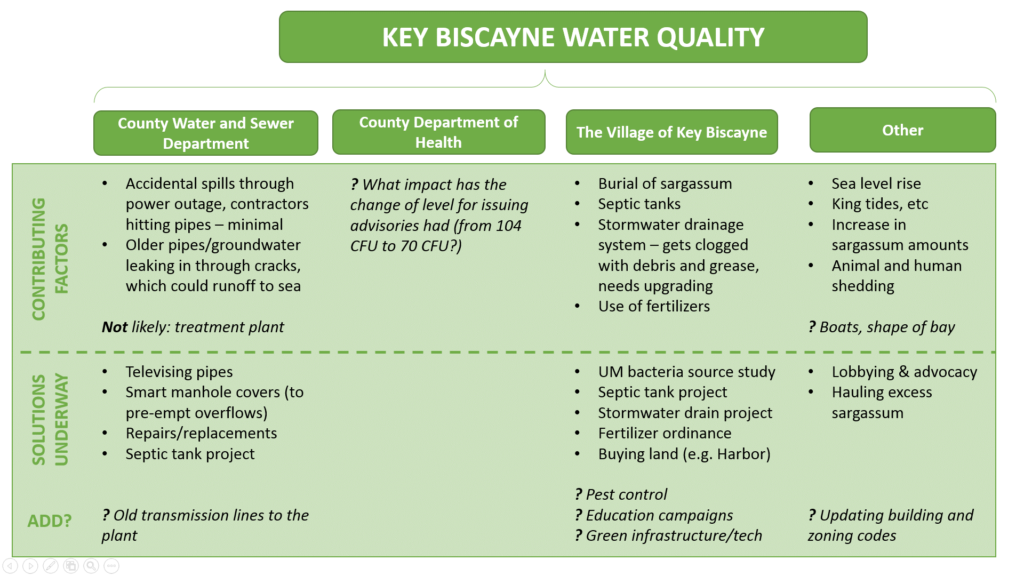Water Quality Workshop a Step in the Right Direction
Annali HaywardNovember 11, 2019

Panelists listen to residents at the Key Biscayne water quality workshop Nov. 5 (Key News/Briana Gibbs)
Officials, residents and experts united in a renewed focus on Key Biscayne beach water quality after a workshop and panel discussion Nov. 5. The aim was partly education, and although some attendees left still wanting solutions, the momentum to find them is clear.
Over 70 people gathered in the Village Council chambers to hear eight experts discuss the problem, which has captured the community’s attention due to the frequency of beach water advisories.
Panelists included Dr. Douglas Yoder, deputy director of the Miami-Dade Water and Sewer Department, Department of Health director of environmental health & engineering Samir Elmir and resilience experts and advocates.
Much of the discussion was not new, but served to reinforce for the public that there is likely a complex mix of factors at play. Some potential causes are shared between multiple bureaucracies, and some have no distinguishable ‘owner’– such as sea level rise.

Causes and solutions discussed at the Key Biscayne water quality workshop. Nov. 5 (Key News/Annali Hayward)
Mayor Mike Davey opened proceedings with a plea for people to “remain involved” with their local government, and to “focus on where we have to put our energies – because it’s not on the chats.”
Village Manager Andrea Agha moderated the group, giving each panelist time to speak, posing questions and allowing questioning between panelists before turning the floor over to residents.
Some residents expressed dissatisfaction with the evening’s discourse. Charles Sherman called it “deplorable,” passionately mourning a lack of marine life off the beach in recent years. “Who is the enemy, if it’s not us?” he asked.
By the time the meeting ended two hours later, Davey surmised his audience were “realizing there is no silver bullet. So let’s get organized. Let’s talk about Tallahassee. Until we have a solution, and we get back to Charles Sherman’s pristine beaches, let’s not stop.”
New information
It appeared to be news to the Village administration that the standard for safe water was reduced from over 103.5 CFU (colony-forming units of enterococci bacteria in 100ml of water) to over 70.5. This means a lower level of bacteria in the water would trigger an advisory than previous years.
Professor Helena Solo-Gabriele said that a couple of years ago – around 2018 – the change happened in response to studies from the Environmental Protection Agency into the bacteria.
Solo-Gabriele is the lead professor of the University of Miami study funded by the Village that is analyzing the DNA source of the bacteria. The third quarterly report of findings is due at the end of the month.
At the time of publication, datasets relating to the change in levels were still outstanding.
“It would be good to take a look at those and see whether the advisories go up after it,” said Solo-Gabriele.
Actions discussed
Immediately following the meeting, the Village Council voted on an additional funding request to be included in their 2020 legislative appropriations bid, which lobbyists will take to Tallahassee in the coming weeks.
The Council voted unanimously to ask for $750,000 to match their own 2020 budget for ‘beach management’ – specifically of sargassum.
In the Village’s current contract with beach management company Beach Raker, set to extend until 2021, sargassum haulage (to the county landfill) is an extra cost on top of the $243,000 annual fee. Director of Building, Zoning, Planning and Public Works Jake Ozyman estimated they hauled about 500 cubic yards at $95 per cubic yard on approximately five days over the summer. He said it is a difficult decision to make with taxpayer money, as often there is more sarsgassum predicted, and hauling relatively small amounts “doesn’t make a dent.” It also picks up sand, which the Village is currently battling to replenish.
The Village also plans to improve stormwater drains, which will help manage runoff. The question for Ozyman will be what level of funding residents and the administration are comfortable with.
Ozyman explained that it is possible, with the right enhancements, to drastically reduce the amount of floodwater that reaches streets – depending on the level of investment. Less flooding means fewer nutrients and less debris ends up in the system, something which panelists widely agreed is a big factor in sea contamination.
Ozyman said there would be an informal session for residents to be involved, learn about the options and ask questions about contractors and process.
As for runoff, a fertilizer ordinance is due on the Village Council agenda before the end of the year.
Davey also mentioned the Village is working on hiring a Chief Resilience Officer. Present on the panel were two resilience experts, Katherine Hagemann, resilience program manager for adaptation from the County resilience team and Elizabeth Wheaton, director of environment and sustainability at Miami Beach. Both advocated strongly for both public education campaigns and more green infrastructure and technologies to help reduce the amount of water retained on the island.
“We have to understand that stormwater is dirty,” said Wheaton. “The ingredients we put on our yards, to wash our cars, when we don’t pick up after our dogs…all that goes into our storm drains.”
“Adding shrubbery, bioswales and rain gardens can also make a big impact,” said Hagemann.
Key News is continuing to investigate this issue, with several lines of inquiry outstanding at the time of publication. Check back for ongoing coverage.


